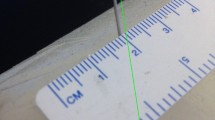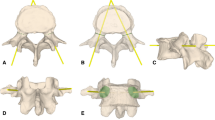Abstract
Purpose
We present a novel augmented reality (AR) surgical navigation system based on ultrasound-assisted registration for pedicle screw placement. This system provides the clinically desired targeting accuracy and reduces radiation exposure.
Methods
Ultrasound (US) is used to perform registration between preoperative computed tomography (CT) images and patient, and the registration is performed by least-squares fitting of these two three-dimensional (3D) point sets of anatomical landmarks taken from US and CT images. An integral videography overlay device is calibrated to accurately display naked-eye 3D images for surgical navigation. We use a 3.0-mm Kirschner wire (K-wire) instead of a pedicle screw in this study, and the K-wire is calibrated to obtain its orientation and tip location. Based on the above registration and calibration, naked-eye 3D images of the planning path and the spine are superimposed onto patient in situ using our AR navigation system. Simultaneously, a 3D image of the K-wire is overlaid accurately on the real one to guide the insertion procedure. The targeting accuracy is evaluated postoperatively by performing a CT scan.
Results
An agar phantom experiment was performed. Eight K-wires were inserted successfully after US-assisted registration, and the mean targeting error and angle error were 3.35 mm and \(2.74{^{\circ }}\), respectively. Furthermore, an additional sheep cadaver experiment was performed. Four K-wires were inserted successfully. The mean targeting error was 3.79 mm and the mean angle error was \(4.51{^{\circ }}\), and US-assisted registration yielded better targeting results than skin markers-based registration (targeting errors: 2.41 vs. 5.18 mm, angle errors: \(3.13{^{\circ }}\) vs. \(5.89{^{\circ }})\).
Conclusion
Experimental outcomes demonstrate that the proposed navigation system has acceptable targeting accuracy. In particular, the proposed navigation method reduces repeated radiation exposure to the patient and surgeons. Therefore, it has promising prospects for clinical use.














Similar content being viewed by others
References
Phillips FM, Cheng I, Rampersaud YR, Akbarnia BA, Pimenta L, Rodgers WB, Uribe JS, Khanna N, Smith WD, Youssef JA (2016) Breaking through the “Glass Ceiling” of minimally invasive spine surgery. SPINE 41 Suppl 8(1):35–58
Laine T, Lund T, Ylikoski M, Lohikoski J, Schlenzka D (2000) Accuracy of pedicle screw insertion with and without computer assistance: a randomised controlled clinical study in 100 consecutive patients. Eur Spine J 9(3):235–240
Smith H, Welsch M, Sasso R, Vaccaro A (2008) Comparison of radiation exposure in lumbar pedicle screw placement with fluoroscopy vs computer-assisted image guidance with intraoperative three-dimensional imaging. J Spinal Cord Med 31(5):532–537
Mastrangelo G, Fedeli U, Fadda E, Giovanazzi A, Scoizzato L, Saia B (2005) Increased cancer risk among surgeons in an orthopaedic hospital. Occup Med 55(6):498–500
Gebhard FT, Kraus MD, Schneider E, Liener UC, Kinzl L, Arand M (2006) Does computer-assisted spine surgery reduce intraoperative radiation doses? SPINE 31(17):2024–2027
Härtl R, Lam KS, Wang J, Korge A, Kandziora F, Audigé L (2013) Worldwide survey on the use of navigation in spine surgery. World Neurosurg 79(1):162–172
Manbachi A, Cobbold RS, Ginsberg HJ (2014) Guided pedicle screw insertion: techniques and training. Spine J 14(1):165–179
Hott JS, Deshmukh VR, Klopfenstein JD, Sonntag VK, Dickman CA, Spetzler RF, Papadopoulos SM (2004) Intraoperative Iso-C C-arm navigation in craniospinal surgery: the first 60 cases. Neurosurgery 54(5):1131–1136 1136-1137
Merloz P, Troccaz J, Vouaillat H, Vasile C, Tonetti J, Eid A, Plaweski S (2007) Fluoroscopy-based navigation system in spine surgery. Proc Inst Mech Eng [H] 221(7):813–820
Galiano K, Obwegeser AA, Bodner G, Freund M, Maurer H, Kamelger FS, Schatzer R, Ploner F (2005) Ultrasound guidance for facet joint injections in the lumbar spine: a computed tomography-controlled feasibility study. Anesth Analg 101(2):579–583
Loizides A, Peer S, Plaikner M, Spiss V, Galiano K, Obernauer J, Gruber H (2011) Ultrasound-guided injections in the lumbar spine. Med Ultrasonogr 13(1):54
Moore J, Clarke C, Bainbridge D, Wedlake C, Wiles A, Pace D, Peters T (2009) Image guidance for spinal facet injections using tracked ultrasound. Med Image Comput Comput Assist Interv 12:516–23
Ungi T, Abolmaesumi P, Jalal R, Welch M, Ayukawa I, Nagpal S, Lasso A, Jaeger M, Borschneck DP, Fichtinger G (2012) Spinal needle navigation by tracked ultrasound snapshots. IEEE Trans Bio-med Eng 59(10):2766–2772
Ungi T, Beiko D, Fuoco M, King F, Holden MS, Fichtinger G, Siemens DR (2014) Tracked ultrasonography snapshots enhance needle guidance for percutaneous renal access: a pilot study. J Endourol 28(9):1040–104515
Blackwell M, Nikou C, Digioia AM, Kanade T (2000) An image overlay system for medical data visualization. Med Image Anal 4(1):67–72
Lippmann G, Lippmann G (1908) Epreuves reversibles donnant la sensation du relief. J Phys Theor Appl 7(1):821–825
Liao, H, Hata, N, Iwahara, M, Nakajima, S, Sakuma, I, Dohi, T (2002) Integral videography: a new 3-D autostereoscopic medical image. In: Icbme’2002 of the international conference on biomedical engineering and rehabilitation engineering
Hongen Liao SNMI, (2001) Intra-operative Real-Time 3-D Information Display System Based on Integral Videography. In: Medical image computing and computer-assisted intervention–Miccai, (2001) International Conference, Utrecht, October 14–17. Proceedings 2001:2001392–400
Liao H, Inomata T, Sakuma I, Dohi T (2010) 3-D augmented reality for MRI-guided surgery using integral videography autostereoscopic image overlay. IEEE Trans Bio-Med Eng 57(6):1476–1486
Wang J, Suenaga H, Hoshi K, Yang L (2014) Augmented reality navigation with automatic marker-free image registration using 3-D image overlay for dental surgery. IEEE Trans Bio-Med Eng 61(4):1295–1304
Hsu PW, Prager RW, Gee AH, Treece GM (2009) Freehand 3D ultrasound calibration: a review. Adv Imaging Biol Med 2009:47–84
Arun KS, Huang TS, Blostein SD (1987) Least-squares fitting of two 3-D point sets. IEEE Trans Pattern Anal Mach Intell 9(5):698–700
Yaniv, Z (2015) Which pivot calibration? In: SPIE medical imaging, International Society for Optics and Photonics, vol. 9415
Wang J, Suenaga H, Liao H, Hoshi K, Yang L, Kobayashi E, Sakuma I (2015) Real-time computer-generated integral imaging and 3D image calibration for augmented reality surgical navigation. Comput Med Imaging Graph 40:147–159
Rampersaud YR, Simon DA, Foley KT (2001) Accuracy requirements for image-guided spinal pedicle screw placement. Spine 26(4):352–359
Glossop ND, Hu RW (1998) Practical accuracy assessment of image guided spine surgery. Presented at the 2nd annual north American program on computer-assisted orthopaedic surgery, Pittsburgh, Pennsylvania, June 1998
Mason A, Paulsen R, Babuska JM, Rajpal S, Burneikiene S, Nelson EL, Villavicencio AT (2014) The accuracy of pedicle screw placement using intraoperative image guidance systems. J Neurosurg Spine 20(2):196–203
Gill S, Mousavi P, Fichtinger G, Chen E, Boisvert J, Pichora D, Abolmaesumi P (2009) Biomechanically constrained groupwise US to CT registration of the lumbar spine. In: International conference on medical image computing and computer-assisted intervention. Springer, pp 803–810
Echeverría R, Cortes C, Bertelsen A, Macia I, Ruíz ÓE, Flórez J (2015) Robust CT to US 3D-3D registration by using principal component analysis and kalman filtering. In: International workshop on computational methods and clinical applications for spine imaging. Springer, Berlin, pp 52–63
Koo TK, Kwok WE (2016) Hierarchical CT to ultrasound registration of the lumbar spine: a comparison with other registration methods. Ann Biomed Eng 44(10):2887–2900
Nagpal S, Abolmaesumi P, Rasoulian A, Ungi T, Hacihaliloglu I, Osborn J, Borschneck DP, Lessoway VA, Rohling RN, Mousavi P (2014) CT to US registration of the lumbar spine: a clinical feasibility study. In: International conference on information processing in computer-assisted interventions. Springer, Berlin, pp 108–117
Nagpal S, Abolmaesumi P, Rasoulian A, Hacihaliloglu I, Ungi T, Osborn J, Lessoway VA, Rudan J, Jaeger M, Rohling RN (2015) A multi-vertebrae CT to US registration of the lumbar spine in clinical data. Int J Comput Assist Radiol Surg 10(9):1371–1381
Acknowledgements
This work is supported in part by National Natural Science Foundation of China (Grant Nos. 81427803, 61361160417, 81271735), Grant-in-Aid of Project 985, and Beijing Municipal Science & Technology Commission (Z151100003915079).
Author information
Authors and Affiliations
Corresponding author
Ethics declarations
Conflict of interest
The authors declare that they have no conflict of interest.
Human participants or animals
This article does not contain studies with human participants or animals performed by any of the authors.
Informed consent
This articles does not contain patient data.
Rights and permissions
About this article
Cite this article
Ma, L., Zhao, Z., Chen, F. et al. Augmented reality surgical navigation with ultrasound-assisted registration for pedicle screw placement: a pilot study. Int J CARS 12, 2205–2215 (2017). https://doi.org/10.1007/s11548-017-1652-z
Received:
Accepted:
Published:
Issue Date:
DOI: https://doi.org/10.1007/s11548-017-1652-z




